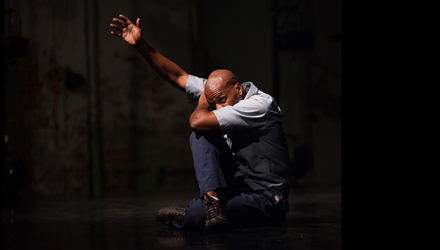
This February Raphael Xavier brings The Unofficial Guide to Audience Watching Performance to Pennsylvania. This work deconstructs Xavier’s songs/rap lyrics, and the art form of breaking (a style of street dancing, commonly referred to as break dancing). It follows Xavier’s evolution from a 13-year old discovering breaking while watching Soul Train to a maturing artist reflecting on his career as a hip hop practitioner. Catch performances in Philadelphia, PA at FRINGE Arts (February 11-13 at 8 pm), and in Bethlehem, PA at Lehigh University’s Zoellner Arts Center (February 16 at 4:30 pm & 19 at 7:30 pm).
We asked the always intentional Mr. Xavier a few questions, sparking some insights on: sharing hip hop with new audiences, clearing the path for breaking practitioners, synthesizing his many artistic practices, and what’s coming up next.
Q: Your hip hop practice focuses on breaking. Can you speak to how you think this moves hip hop forward within our contemporary context?
RX: I wanted to stay with one movement, breaking, to grow and reach a broader audience. At this point, it’s not about me making a hip hop show for an audience made up of only hip hop fans, or my peers in the hip hop world. I want to reach subscriber based audiences- people who would normally feel turned off by hip hop from what they have seen on television. I want them to come to the show, and think, “Wow this is something completely different. I never thought [hip hop] could look like this.”
Q: How have you found that you can be a role model- bringing dancers together so they can express themselves and their identity?
RX: I see myself as someone who is clearing the path- not for hip hop, but for the breaking practitioners to move the dance forward. Everybody’s good- they’ll blow your mind. They can flip, spin. They can do all kind of tricks. They’re strong. But I want to clear the path for people interested in something other than the showmanship of that particular form. If there are dancers who want to just break, they have an avenue to do it.
Q: Recently, you’ve started working with a modern dancer. Can you talk about what working with him has brought to the form?
RX: I brought in Chris [LaPlante] because I wanted to try something different. How can I take my form, my ideas, my structure, and my vocabulary, and put that on this foreign body? What does that look like? How can we make something new? Not a hybrid. But how can it grow?
Q: Artistically, you have practiced not just as a dance artist, but also as a photographer, musician, and stand up comedian. How do you think these practices speak to each other?
RX: Dance, photography and music were the first artistic forms that I practiced. One led to the next to the next to the next, and I always kept them separate. Much later, I moved to California, and started writing comedy, and eventually got a grant to start working on a project there. So I used what I had been doing with comedy- the writing and the rhyming, to start building a different physical performance practice. What I began working on then is what eventually became The Unofficial Guide to Audience Watching Performance. All of these forms- visual art, music, stand up, rap- they all finally came together. And to me that made The Unofficial Guide to Audience Watching Performance the best performance that I have ever created. I was able to synthesize all of these parts of myself.
Q: This September, Raphstravaganza: An Urban Kinetic Experience – a contemporary circus-style performance will premiere at Philadelphia’s City Hall. You will bring together accomplished street performers, extreme BMX riders, acrobatic contortionists, and live music. What excites you the most about this project?
RX: I think it really lets me switch chairs- to be a producer, to do something way bigger than anything I’ve ever done before. I’m paying homage to the culture of street performing which gave me the inspiration, the momentum to do what I’m doing. It also gives me an opportunity to show my appreciation for Philadelphia- a city that has supported me consistently since 1999.
You can learn more about Raphael Xavier here.
Photo © Brian Mengini
**Raphael Xavier’s answers have been edited.
